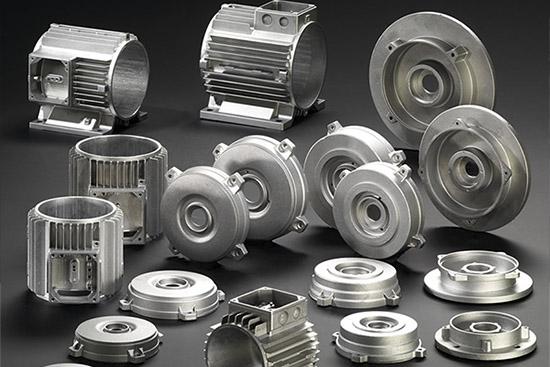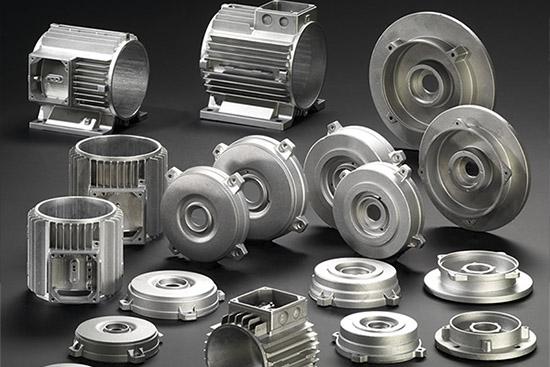During the process of zinc alloy die-casting, we frequently run into some significant issues that impede normal die cast parts production. The most common of these issues is damage to the die-casting mold, which most frequently takes the form of one of the following three types of failure.
-
Failure due to a fracture, including but not limited to plastic fracture failure, fatigue fracture failure, creep fracture failure, low stress brittle fracture failure, medium accelerated fracture failure, and so on.
-
Failure due to excessive deformation, which typically includes both excessive elastic and excessive plastic deformation failure. Because of this, the engineering and technical staff should work quickly to find solutions to the primary problems that are causing these defects. In production practice, it has been found that the chemical composition of the mold steel, the processing quality of the die cast parts, and the heat treatment process have a significant impact on the load-bearing capacity, working life, manufacturing accuracy, and product qualification rate of each mold.
In order to manufacture extruded products that are both high in quality and economically beneficial, comprehensive China die casting manufacturer consideration must be given to the design of the mold structure, the selection of mold material, mechanical processing, heat treatment, production cost, and a variety of other factors.
We are able to determine the decisive factors affecting the failure of the mold based on the appearance of the mold as well as the results of the internal inspection of the mold. Next, we are able to determine the characteristics of the failure of the mold as well as the underlying cause of the damage. When conducting a specific analysis, it is necessary to take into full consideration the organic connection and mutual influence that exists between the various factors.
Early mold failure can be traced to a variety of factors, including inadequate raw material quality, inadequate mold usage conditions, inadequate mold processing methods, inadequate mold blank forging technology, inadequate mold heat treatment technology Ductile Cast Iron, and unreasonable mold structural design. Die-casting molds and their respective working conditions
The forward extrusion punch is the one that is subjected to the majority of compressive stress, whereas the reverse extrusion punch, also known as the composite extrusion punch, is subjected to a significant amount of compressive stress during the extrusion working stroke and to a lesser degree of tensile stress during the return stroke. This stress, which can either be tensile or compressive, is generated in alternating fashion. As a result of this, it is clear that the cold extrusion punch is subject to the combined effects of tension, compression, and bending stress, and that its overall stress state is one that is relatively complex.
Additionally, the cold extrusion process is finished in a very short amount of time, and the large-section blank is converted into a small-section extruded part. This causes the China die casting manufacturer to be subjected to alternating impact loads. This indicates that the mold is subjected to alternating hot and cold stress throughout the manufacturing process. Because of the demanding nature of the work environment, the service life of cold extrusion molds is significantly lower than that of other types of die-casting molds. It is therefore more important to identify the root causes of mold failure and take effective measures to solve them, which is more important for cold extrusion molds than it is for other molds.

This is because in order to extend the service life of the mold, reduce product costs, and improve economic benefits, it is more important to identify the root causes of mold failure. There are a variety of specific factors that influence the mold's service life, and these factors can be broken down into the following six categories:
-
When it comes to extruded parts, the factors related to mold failure include the raw material steel number, part shape and size, extrusion method, degree of deformation, and part dimensional accuracy. When designing extruded parts, these factors are taken into consideration during the design process.
-
In terms of mold design, the following factors affect the service life of the mold during cold extrusion. These factors are as follows:improper utilization of mold materials; unreasonable hardness; sharp corners at the intersection of surfaces; excessive difference between thick and thin walls; and too small of a connection fillet radius; the fiber orientation of the material is unreasonable; the fit accuracy is improper.
-
When it comes to mold materials, some closely related factors should be considered when choosing mold materials. These factors include: poor purity of steel; segregation of chemical components; looseness in the steel; band-like (reticular) carbides; band-like structure; and poor spheroidizing annealing quality.
-
When it comes to heat treatment, some of the factors that can contribute to the failure of a mold are as follows: improper heating speed; improper quenching temperature; improper Ductile Cast Iron cooling speed; improper holding time; improper atmosphere in the furnace; insufficient tempering times; insufficient surface hardness.
-
In terms of use and operation, the following factors are related to mold failure during cold extrusion processing and production: improper installation of the mold; poor lubrication conditions; improper cooling conditions; poor equipment condition; and actual operation that does not follow the requirements.
Die-casting molds are characterized by exceptionally difficult and demanding working conditions. When a mold is used, numerous instances of damage frequently become intertwined with one another. These damages interact with one another and amplify one another, ultimately leading to failure in one or more forms. In order to achieve this goal, it is important to conduct in-depth research and analysis on the variables that impact the useful life of die-casting molds. If you have a wealth of practical experience, you will have the ability to choose efficient methods more quickly. Finish the production with a modern mold.

